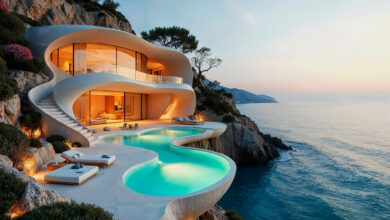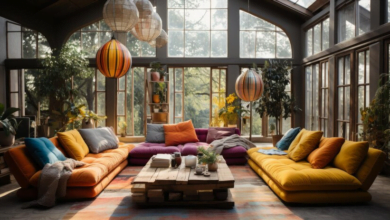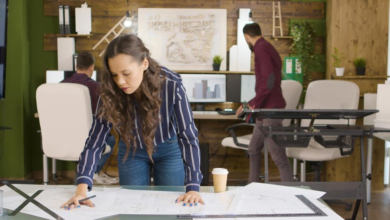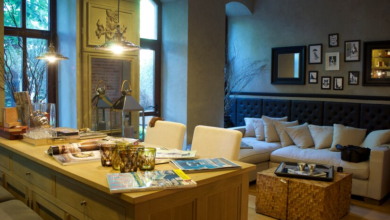
Have you ever wondered what your home will look like in the future? As technology advances and societal values evolve, designers will significantly change how they create living spaces. In this blog post, we’ll delve into some exciting predictions for future interior design trends 2030.
Future Interior Design Trends 2030: What can we expect?
Here’s a list of future interior design trends to expect in 2030.
Sustainable Design
Interior design in 2030 will see a rise in the use of eco-friendly materials and sustainable design practices as environmental consciousness continues to grow. From recycled furnishings and textiles to energy-efficient fixtures, eco-friendly design is going to continue to become the talk of the town. Biophilic design elements bring the outdoors inside, such as indoor gardens, living walls, and natural materials will create connections with nature, enhancing well-being and sustainability in future interior design trends 2030.
Smart Home Design
Another exciting development is the convergence of technology and design. This will lead to more connected, intuitive, and modern smart homes. Integrated automation systems will be controlling everything from lighting to temperature. With security systems, doorbells, and window treatments, homeowners will experience unparalleled levels of convenience and efficiency. Many home furnishings, appliances, and equipment will be activated by voice and sensor.
Multipurpose Furniture
In response to the increasing demand for space-saving solutions, multifunctional furniture will become increasingly popular. Think modular sofas that transform into beds or storage units that adapt to changing needs, enabling homeowners to make the most of their space. They will dominate future interior decorating trends 2030.
Flexible Open-Plan Layouts
While the concept of open-plan living has been popular for some time, we’ll see it evolve to include flexible zoning, use privacy solutions, and create adaptable spaces. Living spaces will use sliding partitions, movable screens, and innovative room dividers. This will allow the creation of rooms within rooms and cater to different activities and moods in the future interior design trends 2030.
Wellness-Centered Spaces
As awareness of well-being grows, designers will create homes that promote health and happiness. Wellness-focused design elements such as biophilic features, maximum natural light penetration, and dedicated relaxation spaces will promote mental and physical well-being.
Flexible Workspaces
The pandemic has changed our lifestyle forever. Most companies offer hybrid and remote working. As remote work continues, homes will need to accommodate flexible work arrangements. In the early stages of adapting to the work-from-home lifestyle necessitated by the pandemic, many of us made do with makeshift workstations, often sitting at the corner of our dining tables or even a simple chair at a table. However, now we’re looking for a dedicated workspace solution. Home offices, ergonomic furniture, and technology-integrated workspaces will enable individuals to be productive and comfortable from home in line with emerging interior design styles 2030.

Virtual Design Consultations
Designers will go online. The rise of remote work and digital communication will make virtual design consultations common, allowing homeowners to collaborate with designers from anywhere in the world and visualize their dream spaces through immersive virtual reality experiences.
Communal Spaces
As focus on community and connection increases, architects and interior designers will create homes that encourage gatherings and interaction. From communal kitchens to shared outdoor spaces like courtyards, residential developments will prioritize community among residents in future interior design trends 2030.
Resilient Design Solutions
With the rising threat of climate change, resilient design will become a priority in environmentally-conscious interior design styles 2030. Homes will be built or retrofitted with features such as flood-resistant materials, storm-resistant windows, and backup power systems to withstand environmental challenges.
Cultural Influences
Globalization will continue to influence design trends, with homeowners and designers drawing inspiration from diverse cultures and traditions. That is why design styles like cross-cultural design and eclectic home décor are becoming increasingly popular. From Turkish-inspired textiles to African ceramics, anticipate the addition of these global influences.
Accessibility Features
We all know the importance accessibility holds in today’s design world. Whether it’s a school, communal dwelling, hospital, or shopping mall, accessibility design concepts are everywhere. Interior design in 2030 will increasingly incorporate adaptive features to accommodate individuals of all ages and abilities. From adjustable height countertops to wheelchair-friendly layouts, homes, offices, and entertainment zones will be designed to ensure comfort, safety, and independence for all occupants.
Vintage Pieces
Everyone wants to remember their roots. Vintage never goes out of style. To embrace nostalgia, vintage and retro elements will be reimagined and integrated into contemporary interiors. Mixing antique finds with modern elements, homeowners will create eclectic spaces that infuse history.
Final Words
The future interior design trends 2030 will be characterized by sustainability, technology integration, versatility, and personalization. As we adopt these trends, our living spaces will not only be stunning to the eye but also functional, resilient, and reflective of our evolving lifestyles and values.
Source: AGA Living



